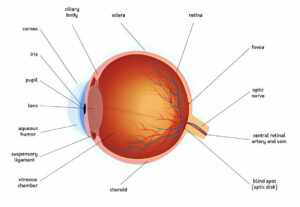
Vision is essential for learning. Students with visual impairments can find support from multiple qualified professionals both within educational settings and other community venues.
Low vision is defined as visual acuity of 20/40 or worse in one eye with correction, excluding blindness (defined as having no light perception, either permanent or temporary).
Causes
Age and eye conditions are among the many causes of visual impairment; moreover, some forms of vision impairment may result from trauma to either the eyes or brain.
The number of people suffering visual impairment varies by country and the availability of preventative eye care services, but worldwide the main causes are uncorrected refractive error, cataract, glaucoma, diabetic retinopathy, hereditary eye diseases and tropical endemic limbo-conjunctivitis – though these aren’t the only reasons for vision impairment; many cases of blindness can be prevented through regular eye care, better diabetes control measures and medication.
Visual impairment has an impactful and varied impact on individual lives; it may interfere with mobility, safety and independence aspects of daily living as well as lead to social isolation or mental health problems.
Visual neglect, a condition which impairs spatial attention, has been associated with bilateral brain lesions on either the right parietal or frontal cortex and/or basal ganglia and thalamus, or it could result from disruptions of large-scale networks controlling visuo-spatial attention (such as arcuate fasciculus).
Experts estimate that up to 80% of learning occurs visually with input and coordination from other senses, so visual impairment can have a devastating effect on education.
Worldwide, an estimated 2.2 billion people suffer from either distance or near vision impairment or blindness; about one billion could benefit from having their sight problems prevented or treated. These individuals include moderate or severe distance vision impairment or blindness due to untreated cataracts, refractive errors, age-related macular degeneration, glaucoma or diabetic retinopathy as well as near vision impairment due to untreated presbyopia – estimates place more than half these people living in low and middle income countries.
Symptoms
Visual impairment symptoms depend on the condition that causes it, with some individuals having central vision loss that makes it hard to see objects straight ahead. Others may only have limited peripheral vision. The severity of symptoms depends on how many visual pathways in their brain have been damaged.
As part of diagnosing vision impairment, the first step involves gathering an in-depth history and performing a physical exam on the patient. A physician will ask questions regarding any discomfort in either eye, how symptoms began, whether they come and go and whether loss of vision affects both eyes or one. They’ll also test your ability to move, focus and perceive colors and shapes through various tests.
Best Corrected Visual Acuity (BCVA) is one of the measures of vision impairment. This measurement can be taken using either a Snellen eye chart or autorefractor and defined as the smallest letter that can be read at 20 feet with their better eye. A BCVA of less than 3/60 indicates legal blindness – something which may be devastating news as this means you will probably struggle to find work, engage in hobbies they enjoy or require special arrangements for.
Blurred vision is often the main symptom, leading to frequent squinting and eye rubbing, while macular degeneration or diabetic retinopathy may lead to blurring and darkening at the center of their field of vision, qualifying a person for legal blindness.
Other symptoms of CVI include difficulty with peripheral vision and double vision that makes navigation difficult, and double vision that makes identifying who’s looking difficult. Many individuals living with CVI also struggle with colour and contrast issues that impede their ability to distinguish similar objects or read text on pages, leading to further social isolation. Finally, those suffering with CVI often struggle with maintaining eye contact leading to social isolation.
Diagnosis
Individuals can be diagnosed with visual impairment if they experience problems using their eyes, such as difficulty with visual acuity, field of vision or color blindness. This could be caused by genetics, eye infections, injury or disease – among many other things.
Legally speaking, someone is considered blind if their best corrected vision falls below 20/200, which is used in the US to establish eligibility for schooling, vocational training, disability benefits, low vision devices and tax exemption programs. According to WHO criteria for low vision someone with vision worse than 20/70 qualifies; those ranging from 20/400-20/1,000 vision loss qualify as having severe or profound impairment.
Age-related macular degeneration (AMD), glaucoma, retinal detachment and cataracts are among the leading causes of blindness in the United States. AMD occurs when macula atrophy occurs causing central and/or peripheral vision loss; while glaucoma affects optic nerve fluid balance leading to increased pressure inside eyes; untreated this could lead to blindness resulting in irreparable vision loss if untreated quickly enough; cataracts remain the number one cause.
Some individuals are born with conditions that inhibit their visual performance, including congenital blindness, traumatic brain injury, cortical visual impairment and strabismus. Others develop these issues over time due to other conditions like diabetes or vascular disease.
Individuals living with visual impairments in the United States can receive support through special education services and an Individualised Family Service Plan or Individualised Education Program, respectively. They may be assigned to a teacher of students with visual impairments (TVI/TVBS). These professionals are specially trained to teach various skills that range from navigating environments safely to using long white canes effectively.
Persons living with visual impairment can seek assistance from low vision specialists and orientation and mobility specialists, both of whom are certified by national associations to train people how to orient themselves independently in familiar environments and navigate using long white canes.
Treatment
Vision impairment affects people of all ages, but certain groups are at higher risk. Seniors are especially prone to vision problems as they age; such as developing age-related vision issues such as glaucoma or diabetic retinopathy that could eventually lead to blindness. Early treatment may prevent further damage while decreasing other health risks. It’s crucial that everyone recognize any sign of visual issues so early treatment may reduce further damage as well as risk.
Low vision loss is a prevalent form of visual impairment and typically describes any level of impairment which makes distinguishing objects, shapes and figures difficult. Individuals living with low vision may still see enough to complete daily tasks but the details might become blurry or distorted, making reading, driving and navigation unsafe or making sports, recreation and work activities challenging for them.
As with other forms of vision loss, many types of visual impairment can be successfully treated if detected and addressed early enough. Treatment options vary depending on its cause; prescription lenses, surgery or other options may be needed depending on its cause; the first step should always be getting an extensive eye exam to identify its root cause.
Eye care providers can diagnose low vision by measuring how well each eye sees, which is known as visual acuity. A person with normal vision is capable of seeing 20/20 on an eye chart while someone with low vision may only be able to see one-tenth. Eye doctors also look at someone’s visual field which covers 120 degrees horizontally and 90 degrees vertically when gazing forward directly; legally blind persons cannot see anything other than their nose when gazing straight ahead.
Vision rehabilitation programs help those with severe visual loss adapt to their limitations by offering support, training and equipment to enhance quality of life. Most states offer funding programs specifically targeted towards helping those with vision disabilities. Eligibility criteria vary by state; typically requiring that a doctor confirm best corrected visual acuity/field in each eye is confirmed as well as national certification as Teacher of Students with Visual Impairments/TVI or Certified Orientation and Mobility Specialist/COMS from ACVREP or NOMC are some requirements of participating in these programs.














